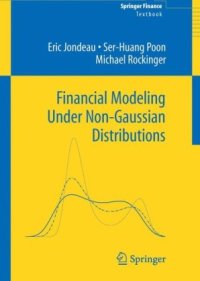
Ebook: Financial modeling under non-gaussian distributions
- Genre: Economy
- Tags: Финансово-экономические дисциплины, Финансовая математика
- Series: Springer Finance
- Year: 2006
- Publisher: Springer
- City: New York
- Edition: 1
- Language: English
- pdf
Practitioners and researchers who have handled financial market data know that asset returns do not behave according to the bell-shaped curve, associated with the Gaussian or normal distribution. Indeed, the use of Gaussian models when the asset return distributions are not normal could lead to a wrong choice of portfolio, the underestimation of extreme losses or mispriced derivative products. Consequently, non-Gaussian models and models based on processes with jumps, are gaining popularity among financial market practitioners.
Non-Gaussian distributions are the key theme of this book which addresses the causes and consequences of non-normality and time dependency in both asset returns and option prices. One of the main aims is to bridge the gap between the theoretical developments and the practical implementations of what many users and researchers perceive as "sophisticated" models or black boxes. The book is written for non-mathematicians who want to model financial market prices so the emphasis throughout is on practice. There are abundant empirical illustrations of the models and techniques described, many of which could be equally applied to other financial time series, such as exchange and interest rates.
The authors have taken care to make the material accessible to anyone with a basic knowledge of statistics, calculus and probability, while at the same time preserving the mathematical rigor and complexity of the original models.
This book will be an essential reference for practitioners in the finance industry, especially those responsible for managing portfolios and monitoring financial risk, but it will also be useful for mathematicians who want to know more about how their mathematical tools are applied in finance, and as a text for advanced courses in empirical finance; financial econometrics and financial derivatives.